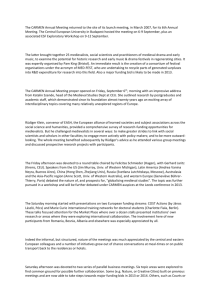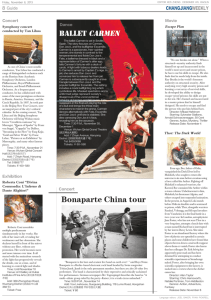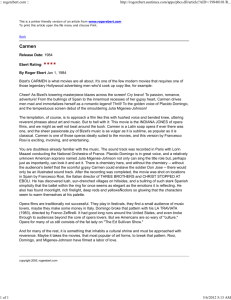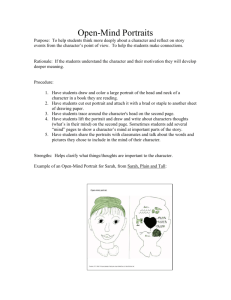THE PORTRAITS OF CARMEN GAUDIN In memory of Professor
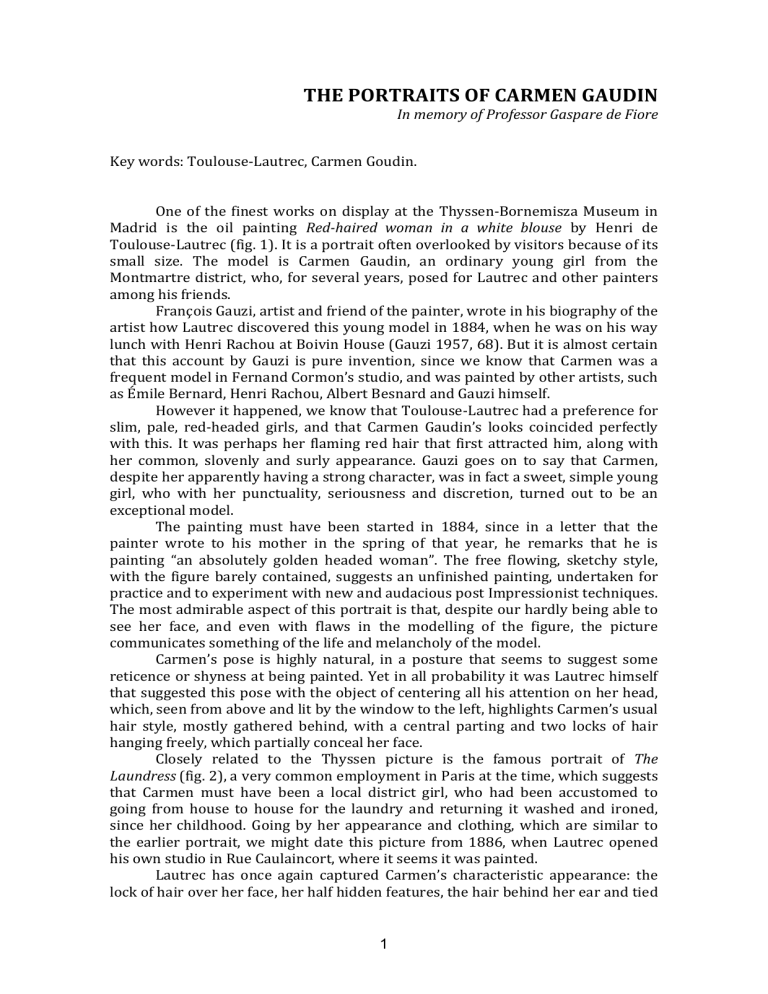
THE PORTRAITS OF CARMEN GAUDIN
In memory of Professor Gaspare de Fiore
Key words: Toulouse-Lautrec, Carmen Goudin.
One of the finest works on display at the Thyssen-Bornemisza Museum in
Madrid is the oil painting Red-haired woman in a white blouse by Henri de
Toulouse-Lautrec (fig. 1). It is a portrait often overlooked by visitors because of its small size. The model is Carmen Gaudin, an ordinary young girl from the
Montmartre district, who, for several years, posed for Lautrec and other painters among his friends.
François Gauzi, artist and friend of the painter, wrote in his biography of the artist how Lautrec discovered this young model in 1884, when he was on his way lunch with Henri Rachou at Boivin House (Gauzi 1957, 68). But it is almost certain that this account by Gauzi is pure invention, since we know that Carmen was a frequent model in Fernand Cormon’s studio, and was painted by other artists, such as Émile Bernard, Henri Rachou, Albert Besnard and Gauzi himself.
However it happened, we know that Toulouse-Lautrec had a preference for slim, pale, red-headed girls, and that Carmen Gaudin’s looks coincided perfectly with this. It was perhaps her flaming red hair that first attracted him, along with her common, slovenly and surly appearance. Gauzi goes on to say that Carmen, despite her apparently having a strong character, was in fact a sweet, simple young girl, who with her punctuality, seriousness and discretion, turned out to be an exceptional model.
The painting must have been started in 1884, since in a letter that the painter wrote to his mother in the spring of that year, he remarks that he is painting “an absolutely golden headed woman”. The free flowing, sketchy style, with the figure barely contained, suggests an unfinished painting, undertaken for practice and to experiment with new and audacious post Impressionist techniques.
The most admirable aspect of this portrait is that, despite our hardly being able to see her face, and even with flaws in the modelling of the figure, the picture communicates something of the life and melancholy of the model.
Carmen’s pose is highly natural, in a posture that seems to suggest some reticence or shyness at being painted. Yet in all probability it was Lautrec himself that suggested this pose with the object of centering all his attention on her head, which, seen from above and lit by the window to the left, highlights Carmen’s usual hair style, mostly gathered behind, with a central parting and two locks of hair hanging freely, which partially conceal her face.
Closely related to the Thyssen picture is the famous portrait of The
Laundress (fig. 2), a very common employment in Paris at the time, which suggests that Carmen must have been a local district girl, who had been accustomed to going from house to house for the laundry and returning it washed and ironed, since her childhood. Going by her appearance and clothing, which are similar to the earlier portrait, we might date this picture from 1886, when Lautrec opened his own studio in Rue Caulaincort, where it seems it was painted.
Lautrec has once again captured Carmen’s characteristic appearance: the lock of hair over her face, her half hidden features, the hair behind her ear and tied
1
at the neck, her chin clearly delineated..., and above all that feeling of boredom, tiredness and melancholy which was present also in the earlier portrait. It seems as though the girl, leaving the clothing on the table, has become distracted, gazing out of the window, escaping for a few moments from the monotony and terrible hardship of her labours.
There is a particular aspect of the painting well worth pointing to: the sensation of its being a snapshot, of frozen movement, of natural posture, rarely seen in earlier portraits. There is no doubt that this range of elements in the framing, view point, posture and expression, are due to the advent of photography, which enabled artists to see and to discover new possibilities in their models. All of which produces a sense of freshness and vitality, given off in Lautrec’s portraits.
There is a third portrait of Carmen, in la Barnes Foundation, with the title “A
Montrouge”–Rosa La Rouge (fig. 3). This title could lead us to believe that the model was not Carmen, but another red-haired girl, called Rose, from Montrouge, a fairly dangerous proletarian district in the south of Paris. However, the title does not actually refer to the name of the girl, but to a song written in 1886 by Aristide
Bruant, Lautrec’s friend. He was the famous singer and master of ceremonies in the nightlife of Paris, whose brazen lyrics, pronounced in the slang of the district, stated that:
C’est Rosa…, j’ sais pas d’où qu’a vient, / Alle a l’poil roux, eun’ têt’ de chien. / Quand a passe, on dit:
V’là la Rouge, / A Montrouge. (It’s Rose, I don’t know where she comes from. Her hair is red, her manner dog-like. When she passes, everyone says: There goes Rose, a Montrouge girl).
In 1885 Bruant had taken on Le Mirliton cabaret and to decorate it he asked
Lautrec for some paintings, which, by way of return, would make him known among his Montmartre customers. Lautrec gave him four oil paintings to which, in agreement with Aristide Bruant, he gave titles naming the Parisian proletarian districts evoked in his songs: A Batignolles, A la Bastille, A Grenelle y A Montrouge.
It is apparent that Lautrec painted this portrait keeping Bruant’s song in mind, which tells Rose’s sordid story of a prostitute from the Montrouge suburbs who, with the aid of her pimp, murdered those who sought her favours during the night. In this portrait, Carmen strikes a careless and provocative pose, with her blouse open and pulled out at the waist, her sleeves rolled up, her hair uncombed, her lips overtly painted, in reddened tones…, all of which helped to recreate the image of the young prostitute in Bruant’s song.
We should add that in 1889 Lautrec painted four illustrations for Le
Courrier français, taking as his theme paintings we was working on at the time. The drawing of Carmen appeared in the issue dated 2 July, with the title Boulevard
extérieur, as though wishing to emphasize the typical features of a street prostitute.
Concentrating on the paintings, it is clear that Lautrec liked several of the girl’s features and gestures: the elusive look, her red hair gathered behind, leaving large loose locks of hair behind her ear and over her face, her neck uncovered and well shaped, her snub nose, her red lips with their protuberant line, her confident chin, in addition to the contrast between her red hair and the white blouse.
In the Albi Museum, dedicated to their illustrious painter, there are two unfinished sketches in which Carmen’s features are recognisable. In the first, we see the model arrayed in the typical black outfit that ordinary people of the period wore (fig. 4). Although it is undated, this portrait must be among the first painted by Lautrec, in around 1884. Those aspects mentioned earlier are prominent: her
2
golden head, the loose locks of hair across her face, her pale sickly skin, her somewhat distrustful look, her still adolescent features…
As in the first sketch, this second is also an unfinished, flawed portrait of
Carmen (fig. 5), and must belong to the first pictures that Lautrec painted, in a period during which the painter was still reaffirming his style and technique: rapid brushwork, diluted colours, common subjects appropriate to realism, and special attention to portraying the psychological aspect of his models.
Carmen looks directly at the painter, who paints her with affection, in warm gentle tones, as though wishing to reflect the innocence or sweetness of her personality, her thin face framed by her two rebellious locks of hair. We should note something, which we will discuss further below, that the nose and mouth are clearly drawn, whereas her eyes have been blurred with black paint, perhaps because Lautrec was not able to capture the particular look of the young girl.
Among all the portraits of Carmen, the painting in Boston Museum is the one which best reflects the extraordinary qualities of Lautrec’s drawing, where line predominates over smudging and colour (fig. 6). This circumstance makes us think that the oil painting faithfully represents Carmen’s face, very similarly to that in the picture commented on earlier. There is something intriguing in the look; although it is straight at the painter, which suggests a certain distrust, as if she were not comfortable and wanted to keep an eye on what might happen around her. On the other hand, the small mouth, tight lips and brow seem to evoke a surly and defiant character, when in reality we know she was quite the contrary.
From her dress and still very youthful features, we can relate this portrait to the earlier ones. It was painted in Lautrec’s studio , of the interior of which we have an approximate idea from his paintings and photographs. The date of the painting is uncertain; all we know is that it was shown in Brussels in February 1888, with a selection of eleven paintings, among which there were various portraits painted over the preceding years.
The portraits we are going to discuss below share certain similarities and differ in some other aspects from those mentioned earlier. Students of Toulouse-
Lautrec’s work have no doubt in recognising in them the model Carmen Gaudin, however, there is no agreement as regards date, since the woman represented in these works is seen to change. She is no longer the near adolescent girl, but an older woman, with less delicate features.
There may be an explanation for this. Carmen disappeared for a given period, returning to Lautrec in order to obtain some money. Lautrec, who knew that Carmen lived with a man that mistreated her, took her as a model once more, although his interests at that time were different.
In this painting, the artist concentrates on the head of the girl, who we see with her usual hairstyle (fig. 7). Being a portrait painted to practice technique and explore some new psychological aspect of the young woman, Lautrec did not mind leaving it unfinished, outlining some details more than others. Carmen’s seated posture, seen a little from above, with a slight turn of the head, is very well done. It is worth pointing out again the power of her look; Lautrec has captured once more a spontaneous gesture, characteristic in his model that only the greatest artists are able to achieve, creating the impression that Carmen has just suddenly turned her head in order to fix her attention on something or someone.
3
In this next portrait, also painted in Forest’s garden, we see Carmen in profile, with such a sense of serenity that we are reminded of the classical restraint of feminine figures by Ghirlandaio (fig. 8). But there is an appreciable difference in this kind of female portrait; where the Renaissance painter draws the entire outline of the face with precision, Lautrec allows Carmen to use her preferred hairstyle to hide part of her features. In the picture we see the neck in every detail, well rounded, the strong jaw, the small mouth with the lower lip protruded, the slightly snub nose…, but not the eye, which we can only glimpse in our imagination.
In the Washington National Gallery portrait, Lautrec tries out another pose for his model; we see her from the front, but with her head turned to the left, towards the light, which falls directly on her profile and her hair (fig. 9). Once again the painting is unfinished, which causes us to direct our attention as always towards Carmen’s mysterious features, she once again hides her look behind her abundant hair, forcing the observer to participate in the recreation of her face, imagining more than the canvas actually shows.
It is worth looking at this portrait very closely in order to appreciate the incredible effect of light that Lautrec was able to achieve with his brush strokes (fig.
10). We believe that this enlarged image explains, better than any text, the illusory effects of the non finito that the Impressionists attempted to reproduce in their canvasses, following a pictorial device, which goes back to the paintings of Titian.
The last picture of Carmen Gaudin that we are going to discuss shows her from the front (fig. 11). As in the earlier works, this one is usually dated 1884, in the period that Lautrec shared a studio with Henri Rachou. If this were the case, we would also have to date the profile portrait of Carmen in the same period (fig.
8), since both have a similar background, so that we might infer that both portraits were those which, with the title Rousse (plein air), were exhibited Brussels in 1888.
However, this portrait has little in common with the other two, in which we see Carmen from the front, and where Lautrec shows us the face of a very young girl (fig. 5 and 6). Consequently, we believe this picture may be related to the three above, all of which were painted outside, in Forest’s garden, later on in the decade of the 80s.
This picture has been reproduced many times in books about the painter, but it is not of his best and gives the impression that Lautrec did not finish his treatment of the face of his model. Although Carmen is seen facing the painter, her look is abstract, as though she were absorbed in her own thoughts. But if we look closely, this effect is due to the fact that Lautrec has painted her without attempting to hide a squint in her left eye.
Is this really the case? If we now look at the two other portraits of Carmen from the front, we notice that in one case Lautrec smudged the eyes of his model with black paint (fig. 5), and in the other he shows us a slight squint in the same left eye, which leads to strange sensation of her look, between distrustful and vigilant (fig. 6).
And with this small detail we would like to summarise some of the characteristics of these portraits. On various occasions we have commented that the main attraction of Carmen as a model lay in this elusive character of her look, hiding her face from us behind her hair, letting herself be painted without showing her eyes, with her head down, or in profile. These poses were not forced on her by
Lautrec, but were instinctive gestures in Carmen, who, conscious that her pretty young face was made less attractive by her squint, tended to hide the defect.
4
Lautrec, an excellent observer of feminine psychology, found a special charm in these gestures, and managed to profit from her dissimulation and paint her as a shy girl, of enigmatic appearance, but with great wealth of interior feeling.
François Gauzi offers us little more information about Carmen (Gauzi, 86). It seems that one day Gauzi asked Lautrec if he could count on Carmen as a model for an allegory of Spring. Lautrec replied that he had dismissed her, since –in the words of the painter– “After a lapse of six months, she came back to ask if I now had any work for her. She is a brunette these days: of course she has no interest for me now”.
What ever happened to Carmen Gaudin? It said somewhere that she died in
1920, following the Great War, when many Parisians suffered considerable hardship, made worse by the Spanish Flu, which took more than half a million lives in France alone. Carmen never knew that Lautrec was to become a famous painter, and that the portraits he made of her would hang in the most important museums.
She, who experienced every kind of privation in her lifetime, could never have imagined that at the Christie’s auction that took place in New York on the evening of the 1st November 2005, one of her portraits, the well-known The Laundress (fig.
2), would attain the record price of $22,416,000.
5
